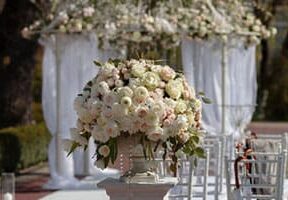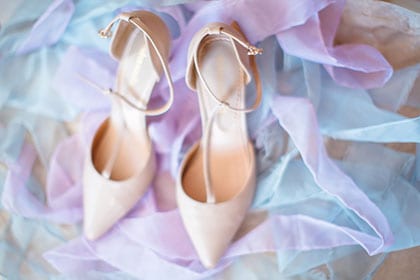
Oct 06
Overall Timetable Running Order Order of Ceremony Table plan – Plan my Wedding
Overall Timetable Running Order Order of Ceremony Table plan
To make sure the day itself goes smoothly, I recommend:
• An overall timetable
• A detailed running order
• An order of day for guests
• An order of ceremony for guests
• Table plan
• Copies of speeches and readings
• List of mobile phone numbers of suppliers and key guests
• Decoration plan.
The overall timetable is a quick reference for you, the suppliers and your attendants. The detailed running order is for suppliers and the lynchpin guests on the day. You may want an order of the day to detail what is happening, so that guests know what to expect after the ceremony. The order of ceremony is to hand out to guests and can be a souvenir of the readings.
Run through the day minute-by-minute to think of every eventuality and prepare contingency plans. Think about how you are going to enter the ceremony room – do you want key guests to be in a procession with you? Should seats be reserved for key people who are reading, being witnesses, or ring bearers? Do you want music to be played as you enter? Do you want music and photos while you sign the register? What about when you leave – do you want guests to leave first and wait for you to sweep down a staircase with them waiting at the bottom, ready to throw confetti at you? If you are a sportsperson, do you want an arch of people holding, for example, hockey sticks or tennis rackets to walk through? Are you going to have a receiving line at the reception? Think about where you want people to take photographs – is there a garden at the venue or somewhere else if it rains? What should other guests do while official family photos are being taken? Do you want someone to read out messages from absent friends? Where will people hang their coats?
Below are examples of the first three detailed plans – these are what we used for our wedding and give you an illustration of what you need to think about.
However, don’t get too stressed if timings go slightly out of kilter; the main thing is that you arrive on time.
Overall timetable
08.00am Wake up – always a good start!
11.00am Drive to Canal Museum to deliver booze and decorations
11.30-12.00 Blow up balloons and store other stuff
12.15pm Check into hotel and have lunch
2.00pm Siesta
2.30pm Bath, make-up, have hair styled and dress
3.55pm Taxi from hotel to registry office, Judd Street
4.00pm Meet photographer, musician and welcoming party
4.15pm Meet with registrar
4.30pm Ceremony at Judd Street
5.30pm Reception at Canal Museum
7.00pm Dinner
8.30pm Live band and dancing
12.00 midnight Taxi back to hotel
Detailed running order
This should include all mobile telephone numbers of any suppliers involved in the day, in case they don’t turn up on time.
08.00am Wake up, pack car with clothes for wedding, evening and next day, make-up, jewellery, contact list, speeches, documents, readings, money, presents for attendants, emergency kit, rings, champagne for hotel, tissues, order of ceremony
10.00am Have hair styled
11.00am Drive to Canal Museum with John and James, Pam and Dermot to drop off wine, soft drinks, champagne, vases, flowers, candles and holders, fairy lights, balloons, Ipod and speakers, table plan, change of clothes for evening, presents for attendants
11.30-12.00 Leave Pam and Dermot to do flowers and balloons; show them how we envisage decorations and give them decoration plan as reference. Give John and James copies of readings, tissues, order of ceremony sheets and maps, to hand out to guests
12.15pm Check into hotel and have lunch
2.00pm Siesta
2.30pm Bath, make-up and dress. Anne to do make-up
3.55pm Martin drives us from hotel to registry office. Don’t forget speeches, handbags and tissues
4.00pm Meet photographer and have a few photographs taken on stairs before guests arrive. John and James set up ceremony room and help musicians set up. John to co-ordinate best people team
4.15pm Interview with registrar. Best people team greets guests, shows them to the ceremony room and hands out tissues and order of ceremony sheets. Also reserves seats for readers. Photographer to take reportage-style photos.
4.30pm Meanwhile, suppliers to arrive at Canal Museum, caterer to chill drinks, set up nine tables of 10 and buffet, put out flowers, table decorations, two bottles of each color wine and water per table, party poppers, place settings, table numbers, conversation clues and table plan upstairs and set up champagne reception downstairs. Band to set up and do sound checks and put up glitter balls and fairy lights upstairs. Chocolate fountain company to set up downstairs. Toastmaster to liaise with caterers and check decoration.
4.30pm Ceremony at Judd Street Registry Office, Council Chambers
• Nicola and Laura to walk in holding hands to sound of Debussy’s Dr Gradus ad Parnassum from Children’s Corner Suite
• Registrar to introduce and conduct ceremony
• Friends to read love quotes
• Nicola’s mother to give first reading
• Nicola and Laura to read poems to each other
• John and James to be ring bearers
• Exchange of rings
• Anne to give final reading
• Signing of register – pianist to play Bach Prelude No. 1
• Nicky and Jo to be witnesses
• Guests leave first, to Debussy’s 1st Arabesque
• Guests wait on stairs to greet Nicola and Laura as they come down the staircase
5.00pm Photos of Nicola and Laura and groups shots on marble stairs of Town Hall. Martin to drive our camper van, which he has decorated, to the front steps
5.15pm Martin to drive us to Canal Museum; photos of us getting in camper van. John and James to have taxi number in case it’s raining and others need transport
5.30pm Reception at Canal Museum
• Photographer to take reportage-style photographs
• Pam and Dermot to check flower arrangements and decorations
• Laura and Nicola to greet guests, caterers to hand out champagne, guests to help themselves to chocolate fountain with help of operator
• When everyone has arrived, toastmaster to introduce speeches by Laura, Nicola, Mark and Pam and toast from Philip and then everyone to continue mingling.
• Toastmaster to check that caterers are ready and music is organized upstairs
• Caterer to supply plated food for band, toastmaster and photographer
7.00pm Dinner – Toastmaster to ask guests to go upstairs, table plan on wall. Caterer to serve two tables at a time and top-up drinks. Band to play background music on playlists through speakers. Hosts of tables to be responsible for attracting waiters if drinks run out
8.30-9.15pm Band to play. Laura and Nicola take first dance
9.00pm Toastmaster and photographer leave
9.15-9.45pm Dance tunes on band’s speakers
9.45-11pm Band to play
11-12.00 midnight Dance tunes on band’s speakers
12.00 midnight Taxi back to hotel. Caterers clear up and leave, storing anything in room booked for storage.
Order of day
4.30pm Welcome to Laura and Nicola’s civil partnership Ceremony starts to music by Helen Jeffes
Introduction by registrar Friends to read love quotes Reading by Nicola’s mother Promises to each other Exchange of rings Reading by Anne
Signing of Civil Partnership Register, music by Helen Jeffes Music by Helen Jeffes Followed by:
5.30pm Pink bubbly reception at Canal Museum
7.00pm Dinner at Canal Museum
8.30pm Live music and dancing
12.00 midnight Carriages
Table plans
If you are having a sit-down meal, it is a good idea to have a seating plan. You know all your guests and you can sit people who you think are compatible on the same table. You can either draw the number of tables you have on a sheet of paper and go through your guest list allocating people to tables, or you can use one of the many seating plan software packages available on the Internet. These allow you to input existing guest lists from spreadsheets. You can then specify who should sit together and who should be apart. The software will assign seats for you and you can adjust as necessary. It will also allow you to mark people with dietary requirements and print off guest lists, table plans, place cards and table cards, if you have not had these printed with your other wedding stationery.
Start your table plan when you have heard back from all your guests, but be prepared to change it right up to the last week, if people drop out. If you are producing the table plan by hand, it is a
good idea to write in the names in pencil until a few days before the big day and then write over them in pen when you are as certain as you can be about who is attending. If you are having the plan printed or are running it off your computer, either leave the final version until the last week or be prepared to make adjustments to it with, for example, sticky labels to cover up names. If you can’t wait until the last week and people drop out, let the caterers know of any changes so they can lay the tables appropriately.
 If you want the meal to be slightly less formal, you can just allocate a specific table to each guest and not prescribe who they sit next to, or you can have a free for all. At first, Laura and I thought we wouldn’t have a seating plan, but we decided we knew who was likely to get on with each other, so we decided to plan it. In fact, as part of the process, we wrote down what we thought people had in common and left what we called conversation clues on each table. This included quirky things, like ‘someone on this table plays the trumpet’, and ‘several of you on this table enjoy photography’. We printed these on the back of the menu cards. We trusted our friends would get on, but every little helps. I remember once being sat next to someone at a wedding because we both had an interest in counselling. Unfortunately, we didn’t know this and never got on to the subject.
If you want the meal to be slightly less formal, you can just allocate a specific table to each guest and not prescribe who they sit next to, or you can have a free for all. At first, Laura and I thought we wouldn’t have a seating plan, but we decided we knew who was likely to get on with each other, so we decided to plan it. In fact, as part of the process, we wrote down what we thought people had in common and left what we called conversation clues on each table. This included quirky things, like ‘someone on this table plays the trumpet’, and ‘several of you on this table enjoy photography’. We printed these on the back of the menu cards. We trusted our friends would get on, but every little helps. I remember once being sat next to someone at a wedding because we both had an interest in counselling. Unfortunately, we didn’t know this and never got on to the subject.
Traditionally, there is a top table at weddings, which is sometimes a long table, facing into the room of round tables for guests. The happy couple are supposed to sit in the middle of the long table with their families or best people fanning out in order of importance away from them. This always strikes me as very formal – like old dons lined up overseeing the activities of their students. Also having nobody opposite you is not very conducive to good conversation. It can also be a nightmare in terms of family politics. A good way round this is to ask family members to host tables and consider only having best friends on your table, which I think should be the same shape as everyone else’s. We also put families who had children of a similar age on the same tables. We kept couples together, but didn’t sit them next to each other since that tends to form a block.
Decoration plan
It is a good idea to draw a plan of the reception room and mark out where you want decorations, how many candles should be on each table, where flowers should go, if anything is hanging from ceilings, where balloons should go, where the DJ or band will be, and where the table plan should be pinned up. Give copies of this to your wedding co-ordinator and anyone responsible for putting out decorations.
Other details
Other options you may want on the day include menu cards, wine lists and table cards to show their numbers – or, for a bit of fun, you may want to give them names, like the ‘Francophiles’ or ‘football fans’.
Another good idea is a guest book, which can be passed around at the dinner for people to write in comments about the day, or wish you well. You could also pass around an instant camera for people to take pictures to stick in the book under their comments. Delegate the task of passing the book around to a specific person, so that it doesn’t get stuck on one table.
Make sure you also have copies of speeches and readings in case people forget to bring them. Run off a few copies of the mobile telephone numbers of key people – your suppliers, the venue, taxi numbers, etc. – and give this to your wedding co-ordinator or attendants.





